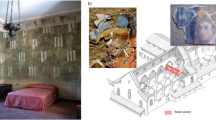Abstract
THE faking of paintings is centuries old. Respectable imitation in the 15th and 16th centuries was followed by more profitable and now flourishing forgery1. Although sophisticated scientific techniques have been applied to problems of authentication2, most of these methods are concerned with the detection of forgeries of works 200 or more years old. The present trend, however, is to forge works of the late 19th century. There are some obvious advantages from the forgers' point of view: artists' materials typical of the period are still available, the production of work in a modern style is easier and less time consuming because very great age is troublesome to fake and, because prices are lower, less care is taken in examination and analysis before purchase.
This is a preview of subscription content, access via your institution
Access options
Subscribe to this journal
Receive 51 print issues and online access
$199.00 per year
only $3.90 per issue
Buy this article
- Purchase on Springer Link
- Instant access to full article PDF
Prices may be subject to local taxes which are calculated during checkout
Similar content being viewed by others
References
Kurz, O., Fakes, 31 (Faber, London, 1958).
Miller, F. J., Sayre, E. V., and Keisch, B., Isotopic Methods of Examination and Authentication in Art and Archaeology (Isotope Information Center, Report No. ORNL-IIC-21, Oak Ridge, 1970).
Keisch, B., Stud. Conservat., 15, 1 (1970).
Libby, W., Berger, R., Mead, J. F., Alexander, G. V., and Ross, J. F., Science, 146, 1170 (1964).
Rafter, T. A., NZJ. Sci., 8, 472 (1965).
Keisch, B., and Miller, H. H., Application of Nuclear Technology to Art Identification Problems—Third Annual Report, 30 (US Atomic Energy Commission Report No. NYO-3953-3, Washington, DC, 1971).
Keisch, B., and Miller, H. H., Application of Nuclear Technology to Art Identification—Final Report, 17 (US Atomic Energy Commission Report No. COO-3034-2, Washington, DC, 1972).
Author information
Authors and Affiliations
Rights and permissions
About this article
Cite this article
KEISCH, B., MILLER, H. Recent Art Forgeries: Detection by Carbon-14 Measurements. Nature 240, 491–492 (1972). https://doi.org/10.1038/240491b0
Received:
Revised:
Issue Date:
DOI: https://doi.org/10.1038/240491b0
This article is cited by
-
Science and works of art
Nature (1974)
Comments
By submitting a comment you agree to abide by our Terms and Community Guidelines. If you find something abusive or that does not comply with our terms or guidelines please flag it as inappropriate.



